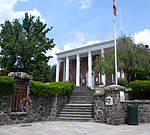Elizabeth Seton College
1961 establishments in New York (state)1989 disestablishments in New York (state)AC with 0 elementsCatholic universities and colleges in New York (state)Education in Yonkers, New York ... and 4 more
Educational institutions disestablished in 1989Educational institutions established in 1961Iona College (New York)Universities and colleges in Westchester County, New York
Elizabeth Seton College (ESC) was a private, Roman Catholic two-year college in Yonkers, New York. Run by the Sisters of Charity of New York, the college opened in 1961 and closed in 1989, merging with the more financially secure Iona College in New Rochelle, New York.
Excerpt from the Wikipedia article Elizabeth Seton College (License: CC BY-SA 3.0, Authors).Elizabeth Seton College
City of Yonkers
Geographical coordinates (GPS) Address Nearby Places Show on map
Geographical coordinates (GPS)
| Latitude | Longitude |
|---|---|
| N 40.9728 ° | E -73.8844 ° |
Address
10703 City of Yonkers
New York, United States
Open on Google Maps







